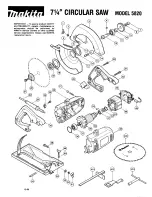
-19-
Instructions on operation:
-
Do not reach with your hands into the sawing area
and do not touch the saw blade. With your other
hand, support the supplementary handle or the
motor casing.
-
Do not reach under the workpiece.
-
Adapt the cutting depth to the workpiece thickness.
-
Never support the workpiece in your hand or over
your leg. Secure the workpiece against a sturdy
support.
-
Only hold the device by its isolated handle
surfaces when carrying out work during which the
cutting tool could hit hidden power cables or its
own connection cable.
-
Always use a limit stop or a straight edge guide for
longitudinal cutting.
-
Always use correctly sized saw blades with
matching receiving bore (e.g. star-shaped or
round).
-
Never use damaged or incorrect saw blade
washers or screws.
-
Hold the saw with both hands and bring your arms
into a position where you are able to resist the
backlash forces. Always keep to the side of the
saw blade. Never bring the saw blade in line with
your body.
-
If the saw blade gets jammed or sawing is
interrupted for some other reason, release the
on/off switch and keep the saw steady in the
material, until the saw blade has come to a
complete standstill. Never try to remove the saw
from the workpiece or to pull it backwards while the
saw blade is still moving or while a backlash could
occur.
-
If you would like to restart a saw that is stuck in the
workpiece, centre the saw blade in the saw slit and
check whether the saw teeth are stuck in the
workpiece.
-
Support large plates to reduce the risk of backlash
caused by a jammed saw blade.
-
Do not use any blunt or damaged saw blades.
-
Before starting to saw, tighten the cutting depth
and cutting angle adjustments.
-
Be especially careful when making a “plunge cut“
into a concealed area, e.g. into an existing wall.
-
Prior to every use, check whether the saw guard is
closing properly. Do not use the saw if the saw
guard is not freely movable and does not close
immediately. Never clamp or tie down the saw
guard in an open position.
-
Check the state and function of the spring for the
saw guard. Have the saw serviced prior to use if
the saw guard and spring do not work properly.
-
When executing a “plunge cut“ that is not executed
at right angles, secure the guide plate of the saw
against lateral shifting.
-
Do not place the saw on the work bench or on the
floor without the saw guard covering the saw
blade.
-
Examine the workpiece for foreign objects. Never
attempt to cut into nails or other metal objects.
Instructions on service and maintenance:
-
Regularly cleaning the machine, especially the
adjusting devices and guides, constitutes an
important safety factor.
-
Only original MAFELL spare parts and accessories
may be used. Otherwise the manufacturer will not
accept any warranty claims and cannot be held
liable.
4
Setting / Adjustment
4.1
Mains connection
Prior to commissioning make sure that the mains
voltage complies with the operating voltage stated on
the machine's rating plate.
4.2
Chip extraction
Connect the machine to a suitable external dust
extractor during all work generating a considerable
amount of dust. The air velocity must be at least 20
m/s (65.6 ft/sec.).
The internal diameter of hose connector 1 (Fig. 1) is
35 mm.
4.3
Saw blade selection
Use a sharp tool to obtain a good cut quality and
select a tool from the following list according to
material and application:
















































